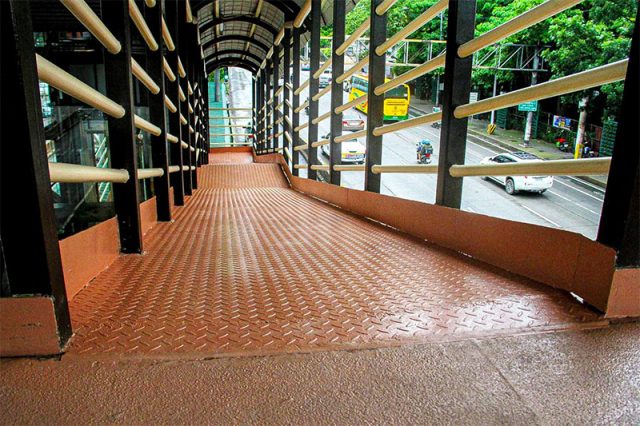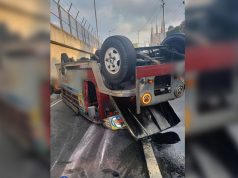
Calls for accountability were raised against the Metropolitan Manila Development Authority which defended its viral ramp installation at an EDSA Busway Station found steeper than the standard.
The MMDA on Wednesday addressed concerns about pictures of a freshly-installed ramp at the new EDSA Philam Busway Station in Quezon City.
The initiative was meant to aid persons with disabilities (PWD) using wheelchairs for mobility, but it quickly drew widespread criticism for its design, specifically its steepness and the material used for its flooring.
Many Filipinos aired concerns about how it resembles a “slide” rather than a ramp meant to help persons in wheelchairs.
Its ability to remain safe during rainy days was also questioned, given the smooth appearance of the flooring which some Pinoys said could become “slippery” when wet.
The MMDA addressed the concerns in a statement posted on its social media accounts, saying that the Metro Rail Transit (MRT) has a “height restriction” it needed to adhere to.
“Hindi naging posible na ipantay ang elevator sa footbridge,” it said.
Some EDSA Busway Stations are located in or near MRT stations.
The MMDA admitted that while its ramp’s design is not perfect, it can still supposedly aid the elderly, pregnant women and other people with disabilities in their commute.
“Hindi ito perpektong disenyo lalo na sa mga naka-wheelchair pero malaking tulong pa rin ito para sa mga senior citizens, buntis at ibang PWDs sa halip na umakyat gamit ang hagdan,” the agency said in a statement on July 17.
It added that it will assign personnel to assist PWDs who would be having difficulty in using the ramp.
“Kumpara sa nag-viral na photo, hindi ito masyadong matarik kung lalakaran,” the MMDA said.
“Inilagay ang rampa dahil sa limitadong espasyo at kung wala ito ay hindi maiilagay ang elevator sa istruktura para sa convenience ng mga commuters na sumasakay sa busway station,” the agency added.
The MMDA’s explanation failed to satisfy some social media users who wanted the agency to be held accountable over the ramp installation.
“Sampahan na ng Kaso ang @MMDA for negligence! House of Senate, imbestigahan bakit walang konsultasyon naganap, sino ang pumayag gawin ito, sinayang ang pera ng Bayan!” a Filipino commented.
“Mag-resign na kayo, [please],” another user wrote in response to the agency’s statement.
A different Filipino said that the “brainchild” of the project should be “terminated” as consequence for the faulty design.
“That will also benefit our PWDs. Your statement regarding constraints on MRT clearly shows that this project should never pushed through unless that statement is just an afterthought (in short, ‘palusot’),” the online user said.
“Imagine, you need to station a dedicated personnel that shouldn’t be doing this kind of job. Not sure [if] that is [24/7],” he added, referring to the promised personnel that will be designated in the ramp.
“Focus on your mandate on why do you exist and not this. I’ve already seen videos who tried that ramp, and it didn’t help and made the matter worse. Our PWD should have their own mobility, but in this case, you will need [one] or [two persons] to assist,” the online user said.
“Admit it, this is a waste of taxpayer’s money and whoever is the brainchild of this project should refund the whole project and [be] terminated from the agency,” he concluded.
Meanwhile, MMDA Traffic Engineering Center Director Neomie Recio said the MRT restriction that resulted in a steeper-than-normal ramp.
“May binigay na requirement ang MRT na kailangan ganito ang awang [niyo] doon sa structure namin. So, kaya nangyari, medyo nag-steep,” she said.
The MMDA also said it will install handrails on the ramp so the PWD, seniors and pregnant women will have something to hold on to while using the structure.
The Accessibility Law, also known as Batas Pambansa 344, ramps for PWD must be inclined at a 4.8 degree angle.
Architect Armand Eustaquio, one of those who crafted the implementing rules and regulations of the law, discovered that the controversial ramp was inclined at 14.15 degrees.
“Sa case nito, mukhang ‘di nila kakayanin unassisted, especially ‘yung mga gumagamit ng wheelchair. Kailangan may magtutulak sa kanila, otherwise medyo delikado ‘to,” he said in an interview.
Wheelchair user Nelson Belo, a member of the non-profit organization Life Haven, was among those who tried the ramp to see how usable it would be for the PWD.
He said that he could not use the ramp as it was too steep for him. It was also dangerous for wheelchair users who needed to go down.
“Kapag dumidiretso ako doon, may bakal nga, baka doon ako sumuot sa bakal,” Belo said.
He hoped the government would consult people like him before moving forward with such initiatives since they are the ones who would use it.
“Sana po pagka gagawa po sila ng ganito (wheelchair ramp), i-ko-konsulta po muna sa amin kasi kami po ‘yung gumagamit nito,” Belo said.
The ramp was difficult to use even if someone had assisted the wheelchair user.









